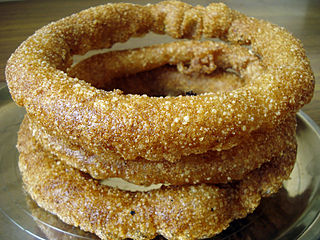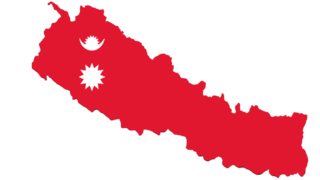
Khaja is an Indian deep-fried pastry, commonly filled with fruit or soaked with sugar syrup.

Chhath is an ancient Hindu festival historically native to the Indian subcontinent, more specifically, the Indian states of Bihar, Uttar Pradesh, Jharkhand and the Nepalese Autonomous provinces of Koshi, Madhesh and Lumbini. Prayers during Chhath puja are dedicated to the solar deity, Surya, to show gratitude and thankfulness for bestowing the bounties of life on earth and to request that certain wishes be granted.

Panchamrita is a mixture of five foods used in Hindu as well as Jain worship and puja and Abhiṣeka It is often used as an offering during pooja post which it is distributed as prasad.

Tihar is a five-day Hindu festival of Diwali celebrated in Nepal and the Indian regions of Sikkim and Gorkhaland, which host a large number of ethnic Nepali Indians.

Puran poli is an Indian sweet flatbread that popular in South India and the state of Maharashtra. It is also known as Puran puri, Holige, Obbattu, Bobbattlu, Poley, Bakshamulu, and Boli.
Mithai (sweets) are the confectionery and desserts of the Indian subcontinent. Thousands of dedicated shops in India, Bangladesh, Nepal, Pakistan and Sri Lanka sell nothing but sweets.

Pithas are a variety of food similar to pancakes, dumplings or fritters, originating from the Indian subcontinent, common in Bangladesh and India. Pitha can be sweet or savoury, and usually made from a dough or batter, which is then steamed, fried or griddled. Very few varieties are oven-baked or boiled, and most are unleavened and cooked on a stovetop. Some versions may have a filling, garnish, or sauce. Few may be set or shaped after cooking. They are typically eaten as a snack with chai, or as treats during special occasions.
Bhojpuri cuisine is a style of food preparation common among the Bhojpuri people of Bihar and eastern Uttar Pradesh in India, and also the Terai region of Nepal. Bhojpuri foods are mostly mild and tend to be less hot in terms of spices used. The cuisine consists of both vegetable and meat dishes.

Poha, also known as pauwa, sira, chira, chivda, avil or avalakki, among many other names, is flattened rice originating from the Indian subcontinent. Rice is parboiled before flattening so that it can be consumed with very little to no cooking. These flakes of rice swell when added to liquid, whether hot or cold, as they absorb water, milk or any other liquids. The thickness of the flakes varies from almost translucently thin to nearly four times thinner than a normal rice grain.

Malpua, or sometimes shortened to pua, is a sweetened breakfast served with morning tea or as a snack with afternoon tea or as a dessert originating from the East Indian subcontinent, popular in Bhutan, India, Nepal and Bangladesh.

Sel roti is a traditional Nepalese ring-shaped sweet fried dough made from rice flour. It is mostly prepared during Dashain and Tihar, widely celebrated Hindu festivals in Nepal as well as Darjeeling, Kalimpong and Sikkim regions in India. The dish is popular throughout Nepal and among the Indian Gorkha community. Sel roti is made from a batter of rice flour, water sugar, ghee, and spices which is then deep-fried in cooking oil.

Shankarpali, shakkarpara, murali, khurma, lakdi mithai, or just simply mithai is an Indian sweet snack made from a dough of sugar, ghee, maida flour, and semolina. The name is derived from Persian Shekarpareh. Shankarpali is eaten in India, especially in Uttar Pradesh. Its variant known as khurma or laktho is also eaten in Bihar, Jharkhand, and eastern Uttar Pradesh. It is also eaten by the Indian diaspora in Fiji, Guyana, Mauritius, Suriname, and Trinidad and Tobago, North America, the United Kingdom, Australia and New Zealand. It is traditionally eaten on Diwali and can be sweet, sour or spicy depending upon how it is made.

Gujhia, also known as Gughara, Pedakiya, Karanji, Kajjikayalu, Somas, and Karjikayi, is a sweet, deep-fried pastry that is a popular dessert in the Indian subcontinent. This delicacy is made using either suji (semolina) or maida, which is stuffed with a mixture of sweetened khoa and dried fruits. The dumpling is then fried in ghee to give it a crispy texture.
Bihari cuisine is eaten mainly in the eastern Indian state of Bihar, as well as in the places where people originating from the state of Bihar have settled: Jharkhand, Eastern Uttar Pradesh, Bangladesh, Nepal, Mauritius, South Africa, Fiji, some cities of Pakistan, Guyana, Trinidad and Tobago, Suriname, Jamaica, and the Caribbean. Bihari cuisine includes Bhojpuri cuisine, Maithil cuisine and Magahi cuisine.
Bihari culture refers to the culture of the Indian state of Bihar. Bihari culture includes Angika culture, Mithila culture, Bhojpuri Culture and the culture of Magadha.

Angika is an Eastern Indo-Aryan language spoken in some parts of the Indian states of Bihar and Jharkhand, as well as in parts of Nepal.

Maithil cuisine, also known as Mithila cuisine, is a part of Indian and Nepalese cuisine. It is the traditional cooking style of Maithils residing in the Mithila region of the subcontinent.
Rupani is a small rural municipality in Saptari District in the Sagarmatha Zone of south-eastern Nepal. At the time of the 2019 Nepal census it had a population of 29,989 people living in about 8500 individual households.

Deo Surya Mandir is a Hindu temple in Bihar, India. The temple is a solar shrine, dedicated to Surya, the sun god, for Chhath Puja. The temple is located in Deo Town, Aurangabad. The Temple is unique as it faces west, the setting sun, not the usual rising sun. It is considered to be one of the most sacred places for sun worshiping and Chhath Puja.














